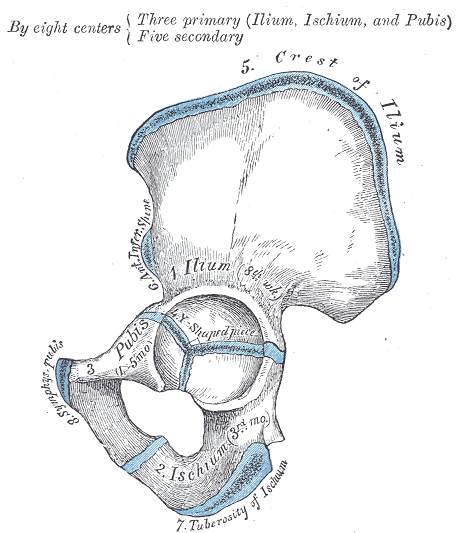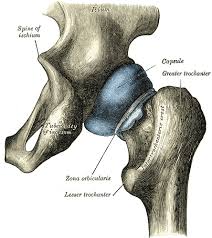Table of Contents
Hip Anatomy

The hip is a ball and socket joint involving the three bones of the pelvis (the ilium, ischium, and pubic bone) and the head of the femur (the thigh bone). The ilium, ischium and pubic bone fuse together at the acetabulum to form a socket shaped surface for the head of the femur to sit within. The acetabulum (the socket of the ball and socket joint) and the head of the femur (the ball) allow for not only stability through the joint, but also a significant amount of mobility.

Surrounding the femoral head sits articular cartilage which allows the hip to access its full range of motion while limiting the stress of friction. The acetabulum has an articulating fibrocartilage layer that makes up the labrum. This fibrocartilaginous labrum creates a tighter seal than the acetabulum alone can provide. This allows for even further stability of the hip joint.

The cartilaginous components of the hip provide mobility and stability, however even further mobility and stability can be attributed to a multitude of musculature surrounding the hip joint.
These muscles of the hip are:
- the iliopsoas (hip flexor)
- the rectus femoris (hip flexor/ knee extensor)
- the “hamstrings” – semitendonosis, semimembranous, and biceps femoris, long head (hip extensors/ knee flexor)
- the gluteus medius (hip abductor/ lateral hip stabilizer)
- the tensor fascia latae (hip abductor/ flexor)
- the iliotibial (I.T.) band (hip abductor/ lateral hip stabilizer)
- the gluteus maximus (hip extensor/ external rotator)
- the piriformis (hip external rotator)
- the superior and inferior gemellus, obturators, quadratus femoris (hip external rotators)
- the pectineus
- the adductor longus, magnus, brevis (hip adductors)
- the sartorius (hip flexor/ external rotator & knee flexor)
- the gracilis (hip adductor/ knee flexor)
Hip Impingement
Hip impingement, or femoroacetabular impingement (FAI), is a dysfunction within the hip joint where the bony and/or cartilaginous structures that support the hip become painful due to repetitive stress and friction. Typically pain will be felt in while the leg and hip are in the position of flexion, adduction and internal rotation. Pain is typically reproduced while performing squatting type maneuvers and sports or entertainment maneuvers requiring high kicks. Sitting, especially with a crossed leg, can also cause pain for individuals with FAI.
My name is Dr. Chad Rush and I put together this video and article so that individuals who may be suffering with these symptoms can start in the right direction and find a fix for their pain.
Typically FAI is a result of chronic and cumulative stress/trauma to the hip. Usually this type of dysfunction is not a direct result of one singular trauma or injury. Individuals suffering with FAI will commonly use compensation techniques to avoid pain, altering their gate and/or movement techniques. These types of compensation can lead to further injury or symptoms in the hip or lower back as well. So, fixing the problem as soon as possible is essential. Especially when it comes to athletic performance. The body acts as a unit or a chain. If one link of the chain is weak it will most definitely affect the rest of the chain. Whether it be running, squatting, pitching, or golfing; the altered performance of a single hip joint can affect entire movement and hinder performance.
Who can help me with my hip impingement?
There are many types of care that can help with femoroacetabular impingement. However, no passive care is complete without the full cooperation of the patient to actively take part in an active rehab protocol. The care that is performed within my office is only one step in the resolution of the problem. Without properly guided and executed corrective exercise, you will never truly find a solution to the problem.
Non-Surgical Practitioners who can help:
CAM and Pincer Deformity
An impingement deformity is a bony overgrowth caused by the repetitive friction seen in FAI. There are three types of impingement deformities; CAM type, Pincer type, and combined and these bony overgrowth’s develop at the femoral head (ball), the acetabulum (socket), or both. These deformities are more prevalent in high activity athletes, especially in younger individuals where the growth plates of the femoral head have not yet fused. Giving the anatomy of the hip being a ball and socket, the hip has a wide range of motion however, when these types of deformities occur, that range of motion becomes limited and pain ensues during motion.
How to tell if you have hip impingment?
First of all, you will be able to tell if you have hip impingement if you are getting pain and a blocking sensation while performing squats, walking, lunging, and/or sitting with your legs crossed. Also, for more accurate testing; the Thomas test, the FAIR test, and the Anterior Hip Impingement test can be used. These tests all involve passive movement of the femur into some form of flexion, adduction and internal rotation. The purpose of these types of tests are to recreate symptoms, such as pinching, pain, and/or a blocking sensation that would indicate a hip impingement type pathology.
Hip Impingement Treatment And Banded Hip Mobilizations
To combat FAI symptoms or to help prevent the start of FAI altogether, Dr. Rush recommends the banded hip mobilizations shown in the video above. Banded hip mobilizations use a strong elastic band to help the hip glide through its intended ranges of motion without restriction. This glide is maintained while the individual moves the hip through active ranges of motion of the hip. Banded hip mobilizations can be used in conjunction with foam rolling and myofascial release to the muscles of the hip as well as proper corrective exercise.




